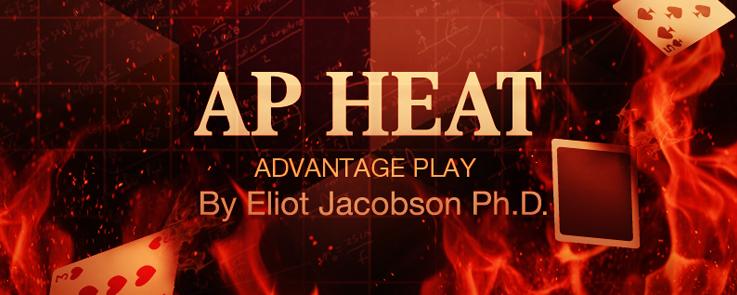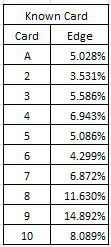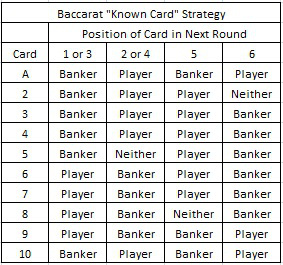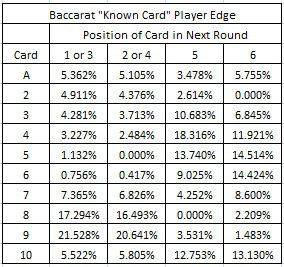Baccarat: The Known Card

Though the game of baccarat appears quite safe to the untrained eye, there are many ways that APs attack baccarat. Some of these methods are targets of opportunity, for example dealers who expose the first card of the next round. Others occur because of perks for high rollers, like dead-chip or loss-rebate programs. There are APs who negotiate specific rule changes that allow methods like edge sorting. Some APs take advantage of long-standing procedural flaws, like the ribbon spread. And then there are all the other ways, whatever they are. This post concerns the "known card."
If the AP knows one of the next six cards in the shoe, then he can gain an easy edge over the house by wagering on the side, Player or Banker, that the card favors. The results in this post assume the standard dealing procedure is used that deals cards 1 and 3 to the player side and cards 2 and 4 to the banker side.
The edges obtainable from a known card are as follows:
- Knowledge of card 1 or 3 (Player first card): 6.765%
- Knowledge of card 2 or 4 (Banker first card): 6.406%
- Knowledge of card 5: 8.973%
- Knowledge of card 6: 9.098%
It may turn out that the dealer exposes a card before the hand is dealt. It may be that sort of incidental mark (e.g. edge sorting) on the first card allows its value to be known in advance. By knowing card 1, the AP will have a 6.765% average edge on the next hand. But there is another way the AP can know a card: if the dealing procedure exposes the bottom card of the shoe during the cut card placement in a way that allows the AP to follow the exposed card through the shoe.
One procedure that can lead to an exposed card is known as the “ribbon spread.” Bill Zender explains the ribbon spread as follows:
“The dealer will remove approximately 20 to 25 cards from the front of the eight decks following the cut. The dealer will spread the card face down on the layout, and starting from the dealer’s left count each card. Once the dealer locates the 14-th card, he/she places the plastic cut card between the 14-th and 15-th. The entire spread of card are picked up in order and placed behind the eight decks.”
If the dealer exposes the bottom card after the 20-to-25 cards are temporarily removed, and the AP gets an exact count of the number of cards removed, then the exposed card can later be located. The AP simply counts the number of cards used in the shoe and waits until his card comes into the six-card window for the next round. Using this method, the average edge the AP will have when the known card is one of the next six cards is 7.402%.
It may take over an hour of waiting for that card to come out, but the potential edge is worth it. A table maximum wager when the known card is due will yield a hefty profit.
The following table gives the edge, by known card:

The following table gives basic “known card” strategy for baccarat:

Note that there are four situations when the AP cannot gain an edge: (card = 5, position = 2 or 4), (card = 8, position = 5), (card = 2, position = 6).
The following table gives the AP’s edge for each possible situation:

Game protection for this ribbon spread issue is easy enough. Don’t use the ribbon spread. Instead, simply instruct the dealer to place the cut card at about one-half deck (26 cards).
Game protection for edge sorting (which gives first card knowledge) is also easy. Include a turn in the shuffle.
As far as other ways of determining a "known card,"cheaters have quite a few tricks up their sleeves, but that's beyond the scope of this blog.


